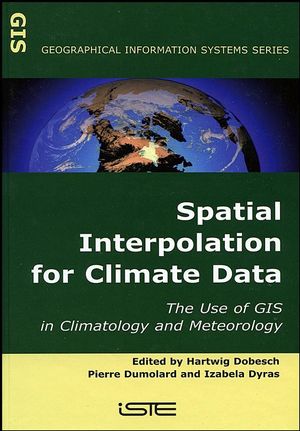Spatial Interpolation for Climate Data: The Use of GIS in Climatology and MeteorologyISBN: 978-1-905209-70-5
Hardcover
302 pages
May 2007, Wiley-ISTE
 This is a Print-on-Demand title. It will be printed specifically to fill your order. Please allow an additional 15-20 days delivery time. The book is not returnable.
|
||||||
Part 1. GIS to Manage and Distribute Climate Data.
Chapter 1. GIS, climatology and meteorology (Antonio Perdigao).
Chapter 2. SIGMA: a Web-based GIS for environmental applications (Carlos Frederico Angelis, Fabiano Morelli, Luiz Augusto Toledo Machado and Cintia Pereira de Freitas).
Chapter 3. Web mapping: different solutions using GIS (Pawel Madej, Malgorzata Barszczynska and Danuta Kubacka).
Chapter 4. Comparison of geostatistical and meteorological interpolation methods (what is what?) (Tamás Szentimrey, Zita Bihari and Sándor Szalai).
Chapter 5. Uncertainty from spatial sampling: a case study in the French Alps (Pierre Dumolard).
Part 2. Spatial Interpolation of Climate Data.
Chapter 6. The Developments in spatialization of meteorological and climatological elements (Ole Einar Tveito).
Chapter 7. The spatial analysis of the selected meteorological fields in the example of Poland (Izabela Dyras and Zbigniew Ustrnul).
Chapter 8. Optimizing the interpolation of temperatures by GIS: a space analysis approach (Jean-Christophe Loubier).
Chapter 9. Daily winter air temperature mapping in mountainous areas (Rémi Lhotellier).
Chapter 10. Aspects concerning the spatialization of radiation balance components (Cristian Valeriu Patriche).
Part 3. Demo Projects.
Chapter 11. The use of GIS applications in meteorology and climatology: a need for the application of regional ecological modeling approaches (Martin Wegehenkel).
Chapter 12. GIS application to daily fire risk mapping (Álvaro Silva).
Chapter 13. Application of GIS technology on the comparisons of climatological databases: an overview of winter precipitation over Spain (M.Y. Luna, M.L. Martin, M.G. Sotillo, C. Almarza, F. Valero and J. de la Cruz).
Chapter 14. Drought sensitivity research in Hungary and influence of climate change on drought sensitivity (Sándor Szalai, Szabolcs Bella and Ákos Németh).
Chapter 15. First steps towards a new temperature climatology of the Greater Alpine Region (GAR) (Wolfgang Schöner, Ingeborg Auer and Reinhard Böhm).
Chapter 16. XRWIS: a new GIS paradigm for winter road maintenance (John E. Thornes, Lee Chapman and Steve White).
Part 4. Climate-related Applications.
Chapter 17. The use of GIS in climatology: challenges in fine scale applications: examples in agrometeorological and urban climate studies (Claude Kergomard).
Chapter 18. Climate impact on the winter land use and land cover management in Brittany (S. Corgne, H. Quénol, O. Planchon and T. Corpetti).
Chapter 19. A tool for the integrated use of remote sensing with ground truth data: DEMETER Project (A. Perdigao, A. Jochum, A. Calera, L. Pessanha, A. Chinita and J. Maia)
Chapter 20. Assessing population exposure to odorous pollution from a landfill over complex terrain (Caroline Riesenmey, Charles Chemel, Hervé Vaillant and Mireille Batton-Hubert).
Chapter 21. Disaggregated estimation of N2O fluxes from agricultural soils of the Italian region by modelization in GIS environment (Anna Carfora, Simona Castaldi, Marco Vigliotti and Riccardo Valentini).
List of Authors.
Index.



